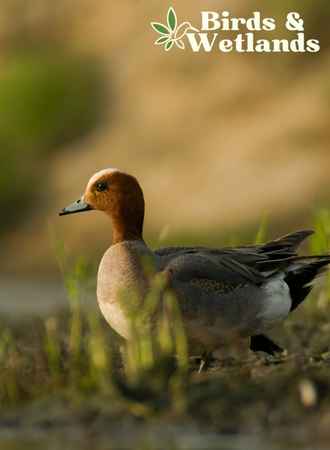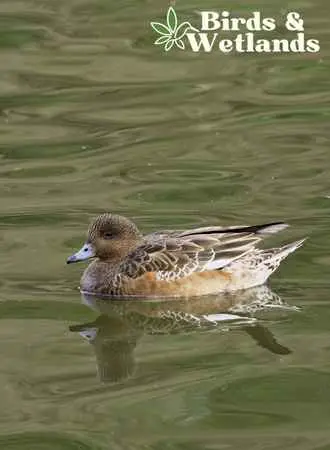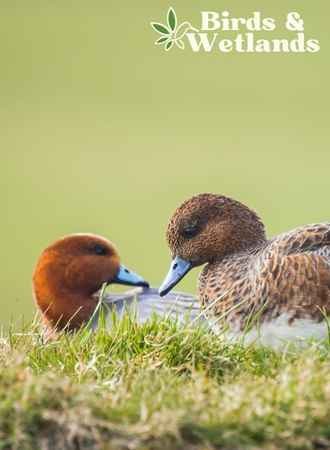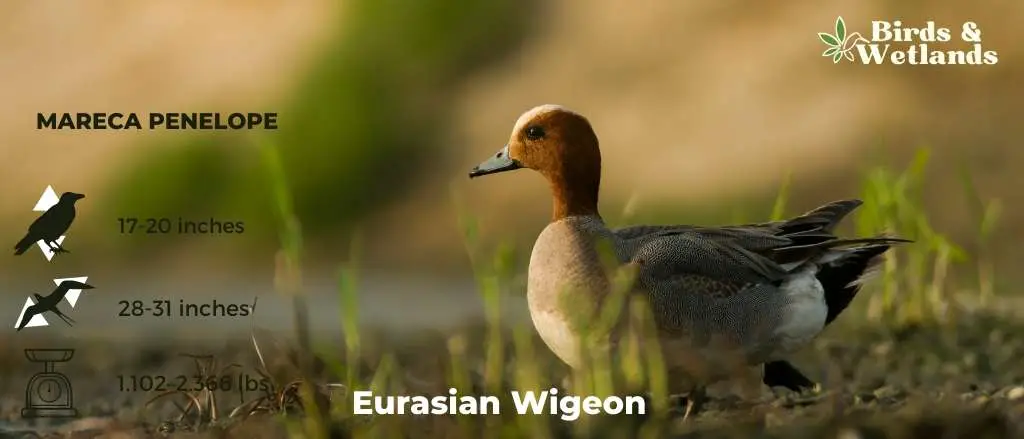The Eurasian Wigeon (formerly Anas penelope) is a widespread dabbling duck found throughout the Palearctic region. They are usually seen in small flocks and prefer to stay near water.
The Eurasian wigeon belongs to the genus Mareca, of which two species of wigeon belong.
Scientific Name: Mareca penelope
Height: 42–52 cm (17–20 in)
Wingspan: 71–80 cm (28–31 in)
Weight: 500–1,073 g (1.102–2.366 lb)
Description
The breeding male Eurasian Wigeon is a striking bird with a chestnut head, white underparts and a black tail. It has gray and white vermiculated upper parts, flanks, and a white patch on the upperwing-coverts.
Adult males in breeding plumage also have elongated gray scapular feathers and a dark green speculum, bordered with black on both sides. The primaries are grayish-brown. The long, gray, tapered tertials are edged with white, and the outer webs are black.
The rump is white and contrasts with the black area surrounding the pale gray and white tail. The bill is pale blue with a black tip and dark brown eyes. It has slate-gray legs and webbed feet.
The female Eurasian wigeon is generally more strongly patterned than the male. It has a round brown head, a short, blue-gray bill with a black tip, and a mostly brown-to-gray body. The face is speckled, while the back and wings are barred or vermiculated with brown.
Its belly is white, with a white patch on the side of the neck. The breast and flanks are light gray to brownish gray with darker barring. The outer webs of the tail feathers are black, while the inner webs are white.

Listen to Eurasian Wigeon
Habitat & Range
The Eurasian Wigeon can be found in large numbers in freshwater wetlands throughout the Palearctic region, Scandanavia, eastern Siberia, the British Isles and through northern Asia to China. They are more common in the winter months but can also be seen on small ponds and lakes during the summer.
The Eurasian Wigeon is a regular winter visitor in much of North America, especially the western United States and southern Canada. It is found wintering with its close relative, the American wigeon. They may have come from northern Europe, as evidenced by birds banded in Iceland.
Eurasian wigeons prefer shallow waters with plenty of vegetation, such as marshes or wet meadows. They will also inhabit estuaries and coastal lagoons near the ocean during migration. They are known to travel long distances searching for food, particularly during winter when food is scarce.

Diet & Food Habits
The Eurasian Wigeon is omnivorous and mostly feeds on plant material such as seeds, grains, and aquatic vegetation brought up by diving ducks. It will also feed on small invertebrates like mollusks and crustaceans.
During the winter, Eurasian wigeons forage in large flocks on fields or mudflats to look for food.
During the summer, Eurasian wigeons may be found during dawn and dusk, feeding around weedy pools or shallow lakes.

Nesting & Mating Habits
The breeding season of the Eurasian wigen usually starts in April or June but varies depending on the range.
The Eurasian Wigeon breeds in the northern Palearctic region during springtime. The nest is a shallow depression lined with down. The nesting site is usually near shallow water with dense vegetation.
Males typically arrive at their breeding grounds before the females and perform an elaborate display to attract a mate. The female will lay 8–10 creamy-white eggs which she will incubate for 24–26 days. Young Eurasian wigeons can fly after 40 to 45 days.

Population & Conservation Status
The Eurasian Wigeon is a widespread species throughout the Palearctic region, with an estimated global population of 1.5 million to 2 million individuals.
It is currently listed as Least Concern by the IUCN Red List. However, there have been some declines in certain areas due to habitat destruction.

Key Points
- Eurasian wigeons are winter visitors of North America and can be seen in mixed flocks with wintering American wigeons.
- The adult male has a chestnut head, white underparts, gray sides and lower breast and a black tail.
- Young males and males in eclipse plumage have a similar appearance as adult females.
- These birds are currently breeding in the Old world but are expected to breed in North America eventually.

